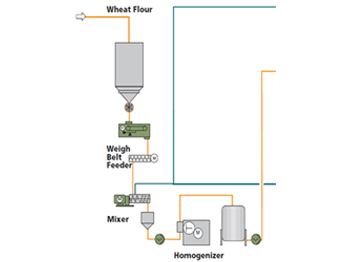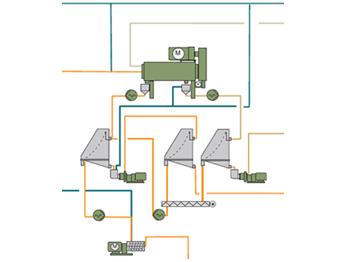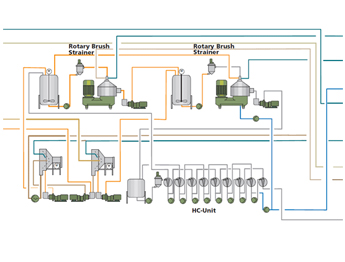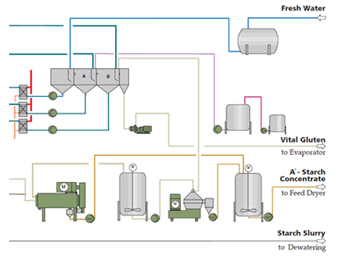Tri-canter Method
3-Phase Separation has become a well-known key element in the wheat starch industry, which is today an environmentfriendly and competitive technology.
Advantages of this processing technology:
a) Water consumption is less
b) Pentosans and other slimy gums are separated at the first beginning of the process by means of three-phase decanter.
c) Better final product quality
Here is a brief review of main stages in Three-phase process for wheat starch production process:
1- Mixing Flour and Water
 Flour is fed to flour storage silo . The water is heated to a certain temperature before it enters the mixer to achieve a smooth pasty consistence of the slurry. The ratio of water to flour is approx. 1:1 depending on the quality of flour.
Flour is fed to flour storage silo . The water is heated to a certain temperature before it enters the mixer to achieve a smooth pasty consistence of the slurry. The ratio of water to flour is approx. 1:1 depending on the quality of flour.
This slurry is pumped by an eccentric screw pump to the high pressure pump. This high pressure pump introduces the mechanical force to aggregate the gluten particles.
Thereby shearing forces are being produced which disintegrate the gluten-starch agglomerates.
2- B-starch & Gluten and A-starch Separation
 The slurry coming from the high pressure pump is fed via a buffer tank to centrifugal three-phase decanter.By means of three-phase decanter , A-starch,Gluten &B-starch and Pentosans are separated .
The slurry coming from the high pressure pump is fed via a buffer tank to centrifugal three-phase decanter.By means of three-phase decanter , A-starch,Gluten &B-starch and Pentosans are separated .
After the gluten leaves the Decanter, it already forms lumps before entering to screening system. Gluten structure is formed and B-starch is washed in gravity screens.Once gluten passed the screen sieves, it goes to gluten washing system for getting better quality gluten. After washing gluten is dried by means of a gluten dryer which generally ring dryer is used.
The underflow from gluten screening which consists mainly of B-Starch still contains some fine gluten particles. In order to recover these fine particles the slurry is check-screened and conveyed to the B-Starch concentration section.
The recovered gluten is recycled.The Pentosane fraction leaves the decanter as light phase and is directly sent to effluent treatment. The concentrated A-Starch passes a heck screen in order to separate some fine gluten particles which are recycled via gluten screening. The A-Starch filtrate is then sent to fibre screening.
3-Starch Separation and Washing
 The A-Starch milk from gluten extractionis fed to a centrifugal screen installation where bran particles and fibres are removed.These are mixed with the A-Starch.The starch milk is collected in a buffer tank and then concentrated in a 3-phase nozzle separator equipped with washing devices. While the clarified overflow from the separator is used as process water the middle phase containing starch and most of the suspended impurities isfed to starch recovery. Finally the concentrated starch milk is washed with freshwater in a multi-stage hydrocyclone systemin counter-current operation.
The A-Starch milk from gluten extractionis fed to a centrifugal screen installation where bran particles and fibres are removed.These are mixed with the A-Starch.The starch milk is collected in a buffer tank and then concentrated in a 3-phase nozzle separator equipped with washing devices. While the clarified overflow from the separator is used as process water the middle phase containing starch and most of the suspended impurities isfed to starch recovery. Finally the concentrated starch milk is washed with freshwater in a multi-stage hydrocyclone systemin counter-current operation.
In order to improve the starch yield even the small granule starch can be recovered. Therefore the B-Starch coming from gluten extractionis subjected to fine fibre removal bymeans of centrifugal screening. The filtrate as well as the middle phase from prime separationis fed to a buffer tank prior to the recuperation section.
For starch recuperationa 3-phase separator is being used. The recovered A-Starch concentrate is recycled prior to prime separation. The B-Starch phase(middle phase) is pumped to the B-Starch concentration section. The overflow of the separator can be used as process water.
4- B-starch Concentration and Process Water System
 The B-Starch fraction as a mixture of the middle phase of B-Starch recovery, along with the pentosanes and fibres are dewatered by means of a decanter. The light phase from the B-Starch decanter is fed to a clarifying separator. The concentrate is collected with the dewatered B-Starch.
The B-Starch fraction as a mixture of the middle phase of B-Starch recovery, along with the pentosanes and fibres are dewatered by means of a decanter. The light phase from the B-Starch decanter is fed to a clarifying separator. The concentrate is collected with the dewatered B-Starch.
The clarified liquid is recycled to balance the process water demand, any surplus is discharged towards effluent treatment.
The process water system is a cascade tank arrangement comprising several tanks for three different water qualities. The freshwater passes through a heat exchanger where it is heated before it enters the system.
5- A-starch Dewatering and Starch Drying
Concentrated A-starch from Hydrocylone Units goes to a dewatering system to be dewatered. Two common machines are used for A-starch dewatering, centrifugal Peeler and Rotary Vaccum Filter.
Dewatered starch goes to air flow starch dryer to get commercial starch.
* Note: Above mentioned THREE-PHASE METHOD comes from Westfalia process.

 What our Customers say
What our Customers say






